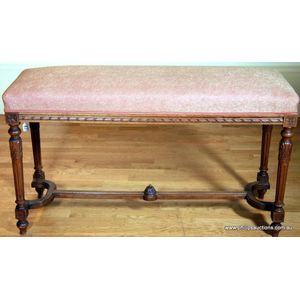Empire Style Walnut Bench with Jacquard Upholstery
You must be a subscriber, and be logged in to view price and dealer details.
Subscribe Now to view actual auction price for this item
When you subscribe, you have the option of setting the currency in which to display prices to $Au, $US, $NZ or Stg.
- Turning - Any part of a piece of furniture that has been turned and shaped with chisels on a lathe. Turned sections include legs, columns, feet, finials, pedestals, stretchers, spindles etc. There have been many varieties and fashions over the centuries: baluster, melon, barley-sugar, bobbin, cotton-reel, rope-twist, and so on. Split turning implies a turned section that has been cut in half lengthwise and applied to a cabinet front as a false decorative support.
- Rosette - A stylised circular-shaped disk with turned or carved decoration decoration applied to a surface, or carved into the surface, especially used in ceramics, jewellery, furniture, sculpture and textiles. Also known as a boss or a paterae or patera.
- Circa - A Latin term meaning 'about', often used in the antique trade to give an approximate date for the piece, usually considered to be five years on either side of the circa year. Thus, circa 1900 means the piece was made about 1900, probably between 1895 and 1905. The expression is sometimes abbreviated to c.1900.
- Acanthus - A stylized leaf motif, one of the primary decorative elements of classical Greek and Roman architecture, derived from the genus of flowering plants in the family Acanthaceae, native to tropical and subtropical regions of the Mediterranean area. It is a common element in classical Greek and Roman design, and is often seen in Corinthian and Composite order columns and used as a decorative element in English, European and Australian furniture, particularly on the curve of a leg, and as decoration for a corbel.
- Terracotta - Terracotta is lightly fired earthenware, red or reddish-brown in colour, used in ancient times. Fired at higher temperatures terracotta was used in the nineteenth century for decorative vases and similar objects, but rarely for utilitarian goods. Other uses for terracotta include roofing tiles, garden pots and ornaments. Glazed terracotta is known as faience.
- Jacquard Fabric - Jacquard fabric is woven on a jacquard loom, which allows intricate and complex patterns to be created. The jacquard loom is controlled by a system of punched cards or a computer program that controls the movement of the loom and allows for the creation of complex patterns in the fabric.
Jacquard fabric is known for its elaborate and detailed designs, which can include intricate floral patterns, geometric designs, and other complex motifs. The patterns are woven into the fabric, rather than printed or embroidered, which gives them a unique texture and depth.
Jacquard fabrics can be made from a variety of fibress, including silk, cotton, wool, and synthetic materials. They are often used for upholstery, drapery, and other decorative applications, as well as for clothing such as dresses, suits, and jackets. - Stretcher - A horizontal rail which connects the legs of stools, chairs, tables and stands, to provide stabilisation of the legs. A stretcher table is any table with a stretcher base. The term is usually applied to substantial farmhouse tables, although many cabinetmaker's pieces, such as sofa tables, also have turned stretchers.
- Empire Style - The Empire style was a version of neo-classicism popular from 1800 to 1830, coinciding with the rule of Napoleon I from 1840-15. In England the style corrosponds with the Regency style and in the United States to the Federal style.
The style is inspired by classical Rome and Greece, as reflected in the decorative motifs in the the design such as paterae, guilloches, acanthus and swags, and pieces are lavishly decorated with applied gilded decoration.
This item has been included into following indexes:
Visually similar items

A Victorian walnut stretcher-based sewing table, 19th century, in beautifully figured walnut with a rectangular top with 'D' ends above a drawer and a paperlined work basket, the turned trestle supports with carved bases and leafy feet united by a turned s

A French marble topped side table, first half 20th century, walnut 'D' shaped table surmounted with rose marble, with running bead design and gadrooned and under tier to match, a frieze drawer with bow shaped motif to centre supported by fluted legs. Heigh

A small Edwardian oak two-tier fold-over card table, early 20th century. 71 cm high, 50 cm wide, 31 cm deep

A French Louis XVI style walnut side table supported on x-stretcher. 75 cm high, 99 cm wide, 61 cm deep.
